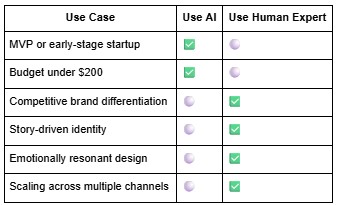

In an era where speed, scalability, and automation dominate the digital space, AI has entered the world of design with bold ambitions. Whether you're launching a side hustle or rebranding a business, AI logo design tools now promise professional-quality visuals—at a fraction of the time and cost.
But how good are these tools really? Can AI generate an emotional, scalable, and differentiated visual identity? Or is it best left as a starting point?
In this post, we explore the pros, cons, and top tools in AI visual identity and branding—plus when to bring in human experts to complete the picture.
The traditional logo design process often involves weeks of creative briefs, moodboarding, iterations, and feedback loops. While this remains valuable for brands needing deep storytelling and unique identity, AI has introduced a viable alternative for those needing speed and affordability.
AI platforms like Looka, Tailor Brands, and Canva AI are now accessible to anyone—no design background needed. And with intuitive interfaces and smart recommendations, these tools help entrepreneurs go from idea to identity in minutes.
AI tools can deliver dozens of logo options within minutes—ideal for startups validating ideas or launching MVPs.
Many tools are trained on years of design principles—offering smart layouts, color psychology, and font pairings out of the box.
Advanced platforms provide brand kits, not just logos. Expect social media templates, business card designs, and presentation themes built from your new identity.
If you're bootstrapping or iterating quickly, AI lets you test and evolve your brand without high up-front investments.
AI tools excel at form, but often lack the why behind the design. They miss context, positioning, and emotional nuance.
Because many AI systems are template-based, brands using the same tool may end up with similar-looking visuals.
AI doesn’t ask about your business goals, competitive market, or brand story. It designs in a vacuum unless guided intentionally.
What looks good on screen might not translate well to packaging, video, or UI. Human-led refinement ensures consistency and polish.

The best strategy? Use AI to test fast, then invest in refinement.
At Dean Marketing, we often meet founders who began with AI—and hit a wall. Their logo looks good, but it doesn’t feel right.
Here’s what we do:
Case Example:
A fitness startup used Tailor Brands for their initial logo. The concept was clean but lacked differentiation. We updated the typography, adjusted color contrast for digital legibility, and expanded their system into merchandise, landing pages, and Instagram assets—leading to a 38% increase in brand recall in surveys.
AI won’t replace great branding—but it can accelerate it.
If you're launching, testing, or rebranding on a budget, AI logo design tools are a powerful starting point. But to build a brand that connects emotionally, scales across mediums, and stands out in crowded markets—you’ll need strategy, storytelling, and human refinement.
With Dean Marketing, you get the best of both worlds: AI efficiency + human creativity = unforgettable branding.
Use these prompts to get better results from AI platforms:
css
CopyEdit
Create a modern, minimalist logo for a wellness brand targeting millennial women. Use calming colors and curved iconography.
css
CopyEdit
Generate a tech-savvy logo for a B2B SaaS product with a bold, trustworthy aesthetic. Prioritize geometric shapes and blue-gray tones.
css
CopyEdit
Design a visual brand identity for a personal finance startup that feels optimistic, secure, and data-driven. Include logo, font, and palette.
vbnet
CopyEdit
Based on the brand mission 'helping busy moms feel strong and seen,' suggest a logo style and three color combinations with emotional resonance.